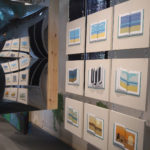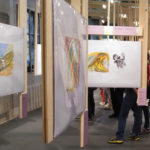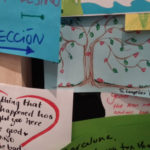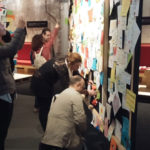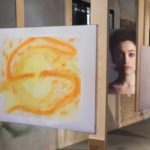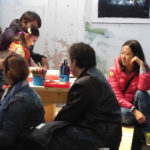
What challenges are there in exhibiting art which has used to help terminally ill patients and their relatives? Nadia Collette, art therapist and curator of Inner Light, talks about the project which resulted in an exhibition in Barcelona in the first half of 2016.
This interview was a French-English collaboration, and the blog begins with a translation, followed by the original responses in French.
What is the idea behind Inner Light?
The basic idea is to convey an encouraging message to society about the possibilities of adapting to the difficult end of life stage and the loss of a loved one, through the exhibition of work done during art therapy. By offering a deeply holistic approach to this process, art therapy can even leave people with great serenity and personal growth. The point of ‘inner light’ is that it is the bereaved themselves, alongside professional artists, who convey this message rather than members of the health team.
Is this a common approach in hospitals?
Art therapy is a discipline which is only minimally introduced in hospitals in Spain. It can benefit patients and their accompanying persons, whether parents, carers and health professionals. An exhibition project like this is a unique approach. We are fortunate that the assembled artworks enjoy a privileged location, thanks to the historic character of the Art Nouveau Site of the Hospital de la Santa Creu i Sant Pau, Barcelona. It caters to a very wide audience of all ages.
How did you come up with the idea?
The idea for the exhibition came from the desire to communicate and share some of the intense moments that I experience as an art therapist when I accompany ill people and their families. It was towards the end of a research project that we were completing in the Palliative Care Unit about the efficacy of the art therapy intervention.
Has there been any resistance to the project?
Initially, the institution didn’t see it as a viable project as the patients and families are exposed to the work of ‘common people’ in a cultural space which functions as a museum. It would have seemed more ‘normal’ to show this kind of work on the outpatient corridor wall or a similar location. But the artistic ambition of the project and the fact that professional artists were also involved eventually helped us to convince the institution.
How did you find funding and get the project into production?
Creative sessions with families and professional artists were filmed, and showing actual images of the running project and not just ideas on paper helped us in the search for economic support needed for production, so that potential contributors were able to have a little more confidence. This stage was particularly difficult for us because we are not specialised in the ‘commercial’ practicalities of such a a project and it was difficult for us to ‘sell’ the fruits of our labour. But at the same time, it’s very important to do this in order to be able to help spread the word about palliative care and art therapy!
Inner light is an initiative of the Hospital de la Santa Creu I Sant Pau, and we are grateful for the funding of Recinte Modernista Sant Pau, Obra Social “la Caixa” (program for comprehensive care to terminally ill individuals and their families), Grupo Mémora, Instituto para la Excelencia Clínica y Sanitaria (INPECS), New Health Foundation, Grunenthal and MEDA.
How did you get in contact with the participants, and was it difficult to persuade them to join in?
Normally, patients are selected for me by the doctors of the palliative care team. Art therapy in the Palliative Care Unit is proposed as a treatment to try to “get better”, but within the context of a scientific study with protocols. In general there is good uptake, but of course there are also people who are not interested in artistic activity, and especially not in their current situation. That’s very understandable. There are also patients who, after a long and painful experience of chemo and radiation therapy, are too tired or who are frightened to give the hospital their consent to be included in studies.
For the Inner Light project, I contacted the families by telephone, from a list of 93 patients who were included in our previous two studies and were deceased, selecting on the basis of the art-therapeutic process and the relationship that we had experienced together. I made sure it was clear from the outset that the main objective was, first, to honour their departed loved one, showing his/her artistic work and, secondly, to help the relatives express their own experience of accompanying the end of life, and of bereavement.
There was little resistance, other practical obstacles, such as people living outside Barcelona or working hours which were difficult to work around. But also, it is true, some persons were in a phase of avoidance or protective mourning and these people preferred not to participate.
It’s interesting to note that even in these cases, people wished me a lot of luck for the project, they felt still like it was a good thing.
Inner Light presents the artistic works of 8 patients and 9 relatives, because in one family there were two family members who wanted to take part.
What is the most important thing about your work?
As a facilitator, I think the most important value to bring to this work is the quality of personal presence, which comes from the profound meaning attributed to the relationship with the other and their suffering. This presence is really only authentic if I myself am connected to my inner wounds, but at the same time remaining aware of personal boundaries to avoid emotional confusion.
My training is varied and somewhat atypical: medical biology license, fine arts degree, master in Art Therapy, doctoral thesis in psychology, master in integrative-relational counselling in bereavement and trauma, continuing education in art therapeutic techniques.
How did you find the right artists for the project?
Artists who participated in the project agreed to first become personally involved in introspection about their own loss and grief. Then each artist chose the patient or family work that attracted them the most. It was art which spoke and ‘decided’ subsequent personal meetings, and not the opposite.
I tried to create a ‘snowball’ effect: an artist friend took me to meet several of his friends, psychologist friends took me to her artist acquaintances, and so on until we had a group gathered. The biggest challenge was to reassure the artists about their apprehensions before meeting with family members because they were worried that some might not respond in the most appropriate way when faced with another’s pain. But the group itself was very supportive.
What was the aim of the film, and how did you work with the filmmakers?
The film is part of the exhibition, showing the creative process behind Inner Light. The interviewees who appear in the film are family members involved in the project.
The filmmakers are two excellent professional creators, Núria Gámiz and Silvia Subirós, a photographer and a documentary maker, who managed to pass almost unnoticed during the shoot.
The aim of the film was to convey to exhibition visitors our work process (making of), a process to they couldn’t otherwise have access. I had long conversations with the film makers to work out some concepts and ideas which then allowed them to create their artistic documentary video.
Luz profunda | Inner light | Pieza documental from nuria gamiz on Vimeo.
Had you planned an exhibition from the outset?
The exhibition project was planned from the start with agreement in advance from all relatives and artists. It was very clear to me that the exhibition space was of great importance and that the assembly was in itself an essential artistic part of the show. I would have refused to continue the project if it had been relegated to the outpatient hospital corridors!
What has been the reaction to the exhibition?
I think people were especially surprised to see the final shape of the assembly such a large and unconventional set. I had planned with the production team that there would be a creative space for public participation, but the reality greatly exceeded our expectations! Visitors respond very spontaneously to the invitation to participate.
This suggests that beyond the taboo hanging over the end of life and bereavement, many people want to make this subject which is so important and universal more visible and integrated. On the contrary, the response of the media is harder to get. All this is still going on and by the end of the exhibition, we hope to see more impact in the press.
- Cat-arte terapéutico: Una exposición de arte terapéutico reflexiona sobre la vida y la muerte, La Vanguardia, 31/05/16
- ‘Luz profunda’, arteterapia heriotzan, Olatz Simon, EiTB, 29/04/16
- Pinceles entre los goteros, María Valerio, El Mundo, 16/06/16
- Luz Profunda, Mary Cuesta, La Vanguardia, 18/06/16
- ‘Siempre hay una luz profunda en la oscuridad’: Grupo Mémora reflexiona sobre la necesidad de un arte terapéutico, Lluís Muñoz, el Periódico de Catalunya, 22/06/16
Is there anything you’d do differently, if you could start again?
Two things I would definitely do differently would be the financing and distribution, which I would take care to have in place from the start.
What was the most rewarding thing about this project?
The most rewarding of this project is to see how thoughtfully visitors browse the exhibition, create their answer on a paper which they hang onto wall panels and which they then photograph before leaving. It’s also gratifying to experience the group meetings with family members and artists. Bonds have been created and we still have a lot to learn!
Perhaps another similar project will be born from these meetings, who knows?
Nadia Collette Birnbaum and Catriona Forrest
Luz profunda. Una experiencia de arte y terapia al final de la vida runs from 22 April to 21 July 2016 at the Recinte Modernista in Barcelona. We would like to thank Nadia for the use of these photographs.
Lumière profonde: organisation d’une exposition de travaux d’art-thérapie réalisés en milieu hospitalier
Quels défis se présentent dans l’utilisation de l’art-thérapie pour aider les patients en phase terminale et leurs proches ? Catriona Forrest demande à Nadia Collette, art-thérapeute et commissaire de Lumière profonde (Inner Light) à propos de son projet qui a abouti à une exposition à l’Hôpital de Sant Pau à Barcelone.
Quelle est l’idée de base de « Lumière profonde » ?
L’idée de base est de transmettre à la société, grâce aux travaux réalisés en art-thérapie, un message encourageant sur les possibilités de s’adapter à la difficile étape de la fin de vie et de la perte d’un être cher. En offrant une profonde approche holistique dans ce processus, cela peut même se vivre avec une grande sérénité et croissance personnelle. L’intérêt de « Lumière profonde », c’est que ce sont les personnes en deuil elles-mêmes, ainsi que des artistes professionnels ceux qui transmettent ce message et non pas les membres de l’équipe de santé.
Est-ce une approche habituelle? Dans les hôpitaux ? A qui cela profite-t-il ?
L’art-thérapie est une discipline encore très peu introduite dans les hôpitaux en Espagne. Elle peut profiter aux patients et à leurs aux accompagnants, que ce soient les parents, les soigneurs ou les professionnels de santé.
Un projet d’exposition comme celui-ci est une approche exceptionnelle. Nous avons la chance que le montage jouisse d’une localisation privilégiée, de par le caractère historique de l’Enceinte moderniste de l’Hôpital de la Santa Creu i Sant Pau, à Barcelone. Elle s’adresse à un public très ample, de tous les âges.
Comment avez-vous eu l’idée ? Que travailliez-vous à l’époque ? Y avait-il une quelconque résistance à l’idée ?
L’idée m’est venue par le souhait de faire connaître et partager quelques-uns des intenses moments vécus comme art-thérapeute lorsque j’accompagne les personnes malades et leurs familles. C’était vers la fin du projet de recherche que nous étions en train de réaliser à l’Unité de Soins Palliatifs sur l’efficacité de notre intervention d’art-thérapie.
Au début, l’institution ne voyait pas viable que des travaux de « personnes courantes », patients et familles, soient exposées dans un espace culturel qui fonctionne comme un musée. Un lieu qui paraissait plus « normal » pour montrer ce genre de productions c’était le mur du couloir des consultations externes… Mais l’ambition artistique du projet et le fait que des artistes professionnels allaient aussi exposer conjointement ont fini par persuader l’institution.
Comment avez-vous réalisé la production? Comment a-t-elle été financée ? Était-ce difficile?
Les sessions créatives avec les familles et les artistes professionnels ont été filmées. Pouvoir montrer des images réelles du projet en marche et non pas seulement des idées sur le papier nous a aidé dans la recherche du support économique nécessaire pour la production, pour que les contributeurs potentiels aient un peu plus confiance. Cette étape a été particulièrement éprouvante pour nous, parce que nous ne sommes pas du tout spécialisés dans la pratique « commerciale » et il nous coûte de « vendre » bien le fruit de notre travail. C’est pourtant une facette très importante pour aider à diffuser les soins palliatifs et l’art-thérapie!
Lumière Profonde est une initiative de l’Hospital de la Santa Creu I Sant Pau, et nous remercions les contributions qui l’ont fait possible : Recinte Modernista Sant Pau, Obra Social “la Caixa” (Program for comprehensive care to terminally ill individuals and their families), Grupo Mémora, Instituto para la Excelencia Clínica y Sanitaria (INPECS), New Health Foundation, Grunenthal and MEDA.
Comment êtes-vous entrée en contact avec les participants, les patients et les parents ?
Habituellement, les patients me sont dérivés par les médecins de l’équipe de soins palliatifs. L’art-thérapie à l’Unité est proposée comme un traitement pour tenter « d’aller mieux », mais dans un contexte d’étude scientifique avec protocole. Il est donc indispensable que la personne malade qui désire essayer signe tout d’abord un consentement informé. En général il y a une bonne acceptation, mais bien sûr il y a aussi des personnes qui ne sont pas intéressées par l’activité artistique, et particulièrement pas dans la situation qu’ils vivent. C’est très compréhensible. Il y a aussi des malades qui, après une longue et douloureuse expérience de chimio et de radiothérapie, sont fatigués ou apeurés d’entrer dans des protocoles à l’hôpital…
Pour le projet, j’ai recontacté les familles par téléphone, d’une liste de 93 patients inclus dans nos deux dernières études et à ce moment-là décédés, en les sélectionnant sur base du processus art-thérapeutique et relationnel que nous avions vécus ensemble. Je leur communiquais dès le départ que l’objectif principal était, d’une part, rendre hommage à leur être cher disparu, en exposant ses travaux artistiques et, d’autre part, s’exprimer sur leur propre expérience d’accompagnant en fin de vie et, à présent, de personne en deuil.
Il y a eu peu de résistance, plutôt des obstacles pratiques, comme par exemple le fait d’habiter en dehors de Barcelone ou que leurs horaires de travail étaient difficilement compatibles. Mais aussi, il est vrai, quelques personnes qui étaient dans une phase du deuil plus évitative ou protectrice et qui préféraient ne pas participer. Il est intéressant de noter que même dans ces cas-là, les personnes m’ont souhaité beaucoup de chance pour le projet, qu’elles sentaient malgré tout comme une bonne initiative.
Finalement, « Lumière profonde » expose les travaux artistiques de 8 patients et 9 parents, parce que dans une des familles, deux membres ont désiré participer
Que pouvez-vous dire au sujet du facilitateur, comment avez-vous appris à faire un travail comme celui-ci, et quelle est d’après vous de la plus grande valeur de votre travail? Il serait intéressant de faire un bref résumé de votre formation.
Comme facilitatrice, je pense que la valeur la plus importante à apporter dans ce travail est la qualité de présence personnelle, qui provient du sens profond attribué à la relation à l’autre qui est en souffrance. Cette présence n’est authentique que si je suis moi-même connectée à mes blessures intérieures, mais en même temps bien consciente des limites personnelles pour éviter les confusions émotionnelles.
Ma formation est variée et un peu atypique : licence en biologie médicale, licence en beaux-arts, master en art-thérapie, thèse doctorale en psychologie, master en counseling intégratif-relationnel du deuil et trauma, formation continue en techniques art-thérapeutiques.
Comment êtes-vous entrée en contact avec le cinéaste, et quel était le processus pour que les participants se sentent à l’aise en étant filmés?
Le film vidéo des sessions fait partie de l’exposition, comme making of du processus créatif. Les personnes interviewées qui y apparaissent sont les membres des familles. Les auteures du film sont deux excellentes créatrices professionnelles, Núria Gámiz et Silvia Subirós, une photographe et une documentariste, qui ont réussi le grand défi de passer presque inaperçues durant le tournage. L’objectif du film était de faire comprendre au futur visiteur de l’exposition notre processus de travail (making of), auquel il ne peut avoir accès d’une autre manière. J’ai eu de longues conversations avec les auteures pour travailler les outils conceptuels qui leur ont permis ensuite de créer leur vidéo documentaire artistique.
Luz profunda | Inner light | Pieza documental from nuria gamiz on Vimeo.
Qu’en est-il des artistes? Comment les avez-vous trouvés, et comment les avez-vous persuadés de participer? Quels ont été, le cas échéant, les plus grands défis?
Les artistes qui ont participé au projet ont accepté de tout d’abord s’engager personnellement dans une introspection sur leurs propres pertes et deuils. Ensuite, chaque artiste a choisi une œuvre de patient ou parent qui l’attirait le plus. C’est l’art qui a parlé et « décidé » des rencontres personnelles postérieures et non pas le contraire.
Je les ai cherchés par effet « boule de neige » : un ami artiste m’a conduite à plusieurs de ses amis, des amies psychologues m’ont conduite à des artistes de leurs connaissances, etc. Le plus grand challenge a été de les rassurer quand j’ai senti croître leurs appréhensions avant la rencontre avec les membres des familles, parce qu’ils craignaient un peu de ne pas répondre de la forme la plus appropriée face à la douleur de l’autre. Mais le groupe lui-même a exercé une bonne contention.
L’exposition – l’aviez-vous prévue dès le départ? Son emplacement et sa promotion étaient-ils décidés dès le début, ou ont-ils été décidés parce que les résultats de l’atelier étaient si bons?
Le projet d’exposition a été planifié depuis le départ et accordé avec les participants. Il était très clair pour moi que la salle avait une grande importance et que le montage était en soi une pièce artistique indispensable de l’exposition. J’aurais refusé de continuer le projet s’il avait été relégué aux couloirs de consultation externe de l’hôpital!
Quelle a été la réaction à l’exposition ? Y a-t-il eu des mentions dans la presse? Les gens ont-ils pris part ? Que pouvez-vous dire au sujet des panneaux muraux et comment les gens interagissent-ils avec eux?
Je pense que la réaction a été surtout de surprise de voir la forme finale du montage, comme un grand ensemble peu conventionnel. J’avais prévu avec l’équipe de production qu’il y aurait un espace créatif de participation du public, mais la réalité a dépassé très largement nos expectatives! Les visiteurs répondent très spontanément et massivement à l’invitation. Ceci nous suggère qu’au-delà du tabou qui plane sur la fin de vie et le deuil, beaucoup de gens désirent rendre plus visible et intégré ce sujet tellement important et universel. Par contre, la réponse des media est plus difficile à obtenir… Tout cela est en cours et d’ici la fin de l’exposition, nous espérons voir plus de répercussions dans la presse.
- Cat-arte terapéutico: Una exposición de arte terapéutico reflexiona sobre la vida y la muerte, La Vanguardia, 31/05/16
- ‘Luz profunda’, arteterapia heriotzan, Olatz Simon, EiTB, 29/04/16
- Pinceles entre los goteros, María Valerio, El Mundo, 16/06/16
- Luz Profunda, Mary Cuesta, La Vanguardia, 18/06/16
- ‘Siempre hay una luz profunda en la oscuridad’: Grupo Mémora reflexiona sobre la necesidad de un arte terapéutico, Lluís Muñoz, el Periódico de Catalunya, 22/06/16
Quelle a été la chose la plus gratifiante de ce projet? Voudriez-vous faire quelque chose de similaire à nouveau, et si oui, que changeriez-vous?
Le plus gratifiant de ce projet est de voir comment les visiteurs parcourent l’exposition avec recueillement, créent leur réponse sur un papier, vont l’accrocher sur les panneaux et puis le photographient avant de s’en aller. Un autre aspect très gratifiant est de vivre actuellement les rencontres en groupe avec les membres des familles et les artistes. Des liens se sont créés et nous avons encore beaucoup de choses à nous raconter!
Peut-être que de ces rencontres va naître un autre projet similaire, qui sait ? Deux choses seraient sûrement différentes, le financement et la diffusion, mieux assurés depuis le départ.
Nadia Collette Birnbaum et Catriona Forrest
Based in Barcelona, Nadia Collette Birnbaum is a member of the Spanish Association of Art Therapists. She studied applied medical biology at the Université Libre de Bruxelles and Fine Arts at the Universidad Politécnica de Valencia. She has a Masters in art therapy and human development from Instituto de Sociología y Psicología Aplicadas de Barcelona (ISPA, presently IATBA) approved by the European Graduate School Switzerland (EGS), and a Masters in integrative-relational counseling in bereavement, loss and trauma from the Instituto de Psicoterapia Integrativo-Relacional en Duelo (IPIR), Barcelona. She has a doctorate in Psychology.




